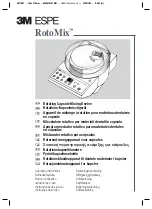
3
CHECKOUT
WARNING
Explosion or Fire Hazard.
Can cause serious injury, death or property damage.
Follow instructions on opening and closing fuel
valves carefully to prevent fuel buildup and possible
fire or explosion.
After the S720B installation has been completed, make the following
checks to ensure that the system is working properly.
Ignition Spark Response Test
The flame relay should not respond (pull in) to ignition spark.
To determine flame detector sensitivity to ignition spark, per-
form the following steps:
(1) Shut off the fuel supply to both pilot and main fuel valve
manually.
(2) Start system by raising controller set point or pressing start
button.
(3) Energize the S720B Igniter so that ignition spark is pro-
duced between electrode and ground.
(4) Check to make sure that ignition has not occurred (there
should be no flame). Repeat steps 1 through 3 until there is
no flame.
(5) Check the flame relay on the burner controller or the flame
LED. If the relay has not pulled in (flame LED is off), the
system is operating properly. Restore the fuel supply and
continue the checkout with the Pilot Turndown Test.
(6) If the flame relay pulls in (flame LED is on), stop the system
as the burner controller is indicating flame regardless of the
condition of the pilot or main burner flame.
(7) If a flame rod sensor is being used, ignition interference
may be the cause of relay pull in. Ignition interference is
most easily detected by measuring the flame current with
the ignition off, then on. A difference greater than 1/2 mi-
croampere indicates the presence of ignition interference.
If ignition interference is detected, take the appropriate fol-
lowing steps:
a. Check for correct spacing of ignition electrode gap.
b. Depending upon the particular situation, rearrange the
flame electrode, ignition electrode and ground to provide
sufficient physical spacing to prevent electrical interac-
tion (interference) between these components.
c. Add more ground area in the form of a flat plate between
the flame rod and ignition electrode.
d. Try wrapping the ground lead around the igniter wire as
shown in Fig. 1, if not already done.
e. Repeat steps 1 through 6.
(8) If the flame relay pulls in (flame LED is on), replace the
burner controller.
(9) If replacing the burner controller does not eliminate flame
relay pull in (flame LED on), contact your local Azbil
branch office.
(10) If an ultraviolet (UV) flame detector is being used, the UV
detector may be responding to the UV radiation being
emitted by the electric spark. To determine whether the UV
detector is responding to the ignition spark and to eliminate
the response, try the following steps to eliminate the spark
pickup:
a. Sight the UV detector far enough out on the pilot flame
so the ignition spark is not sensed. If sensed, reverse the
S720B power leadwires.
b. Construct a barrier to block the ignition spark from the
UV detector view.
c. Reposition the ignition electrode so it is screened by the
pilot burner itself.
d. Restrict the UV detector viewing angle by using a slightly
longer sighting pipe.
e. Repeat steps 1 through 6.
(11) If the flame relay pulls in (Flame LED on), replace the
burner controller.
(12) If replacement of the burner controller does not eliminate
the relay pull in, contact your local Azbil branch office.
Pilot Turndown Test
Refer to the burner controller instructions for the exact proce-
dure to be used in performing the pilot turndown test.
Final Checkout
After other checks have been completed, restore the system to
normal operation and observe at least one complete cycle to be
sure of satisfactory burner operation.






















